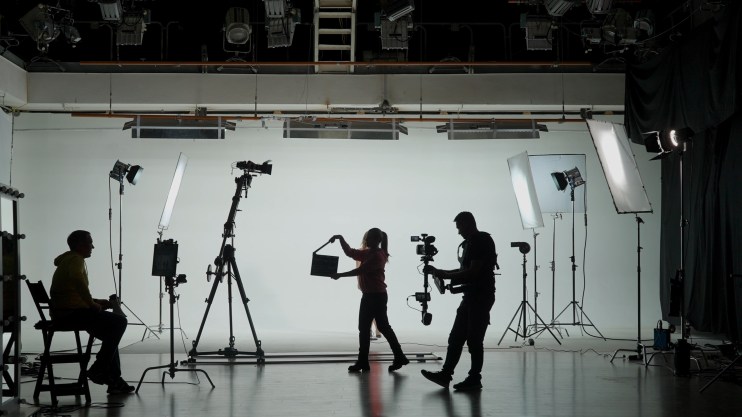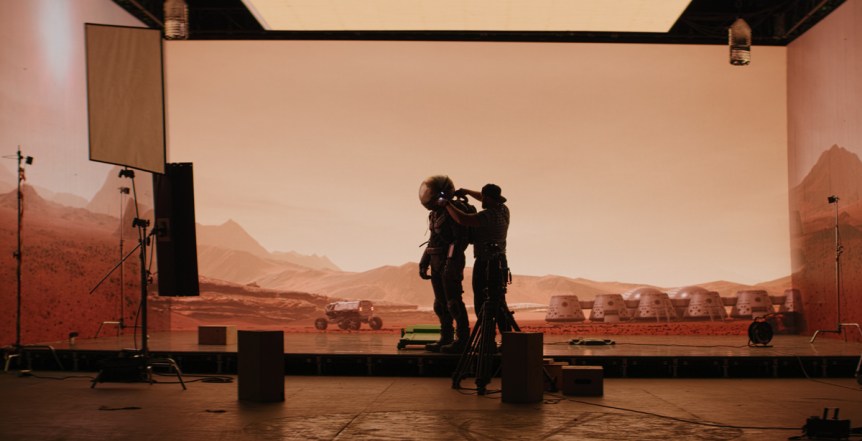If you’ve paid attention to the Film—or even TV—landscape over the last decade, you’re probably no stranger to virtual production. Here at TurboSquid, it’s not uncommon to open up Slack and see our team sharing behind-the-scenes videos from shows like The Mandalorian and House of the Dragon, detailing how they pulled off some of the most epic, cinematic moments in their productions.
These shows feature fantastical worlds in diverse and dangerous settings where filming on location can be costly and carbon-intensive. This is where virtual production comes in, and with it, a plethora of sustainability and financial benefits.
In fact, Shutterstock Studios is already using it in the ad world for companies like Reckitt and Procter & Gamble. We’ve already seen the advantages. Now, we want to explore why your organization should consider it too.
Old vs. new
Think about some of your favorite classic movie. Chances are, transporting the actors, production teams, and equipment to one or many locations came with a sizable carbon footprint. Then factor in building out sets, re-shoots, and all the other common filmmaking costs, and you can quickly see how your environmental impact goes from green to red.
The use of green and blue screens has moved film production in a greener direction (no pun intended). Through post-production, directors could now bring a location to their actors on the set. Less transportation hassle and more control over lighting on-set are nice benefits; however, the trade-off was that the actors needed to use more of their imagination to immerse themselves in the scene.
More recently, LED wall production has progressed to include high-resolution screens that can display realistic backgrounds and environments, using game engines like Unreal Engine or Unity to display the virtual environments in real time. Some of these sets are massive, but others are simply a curved wall with some set dressing in front of it. That’s the magic of virtual production; even a smaller wall can become whatever environment you load into the game engine and project onto it.
Aside from its flexibility, this method also reduces the amount of single-use set waste for a project and provides more control over your environment. For instance, rather than traveling to desert locations, The Mandalorian production team used an impressively large set for season 1 of the Disney+ show, later noting the project reduced carbon emissions by 30 tons.
Environmental benefits of virtual production
Similar carbon reductions are happening in television production, such as when the BBC used remote XR stages for its Tokyo Olympics coverage, which was estimated to reduce crew travel by 30 to 40 percent. But what we like about virtual production is that sometimes, you don’t even need a physical object around to make a set come to life.
Take a look at the variety of vases on TurboSquid with the real-time label applied, and you can see the potential for adding any of these to a scene. We previously blogged about some other advantages of virtual production if you want to learn more.
Another nice benefit is the energy savings. A 2022 study compared two projects and found some surprising outcomes. One company used a green screen, offline rendering, and post-production. The other used virtual production, shooting with an LED wall for in-camera effects. The result? The green screen project clocked in at 5,073 kWh vs. the virtual production project’s 1,594 kWh—a 68% reduction.

What to consider next
Ready to leverage virtual production’s benefits? Two big hurdles to adapting it to your workflows are the initial investment in the tech and the expertise needed to begin and complete the project. LED walls aren’t cheap; setting up a virtual production studio requires real investment, including hiring people who know what they’re doing.
If you’re experienced with 3D modeling, you might know that game engines are relatively inexpensive for beginners, initially limited only by the power of your computer and the spare time you have to learn the engine. We’ve seen some fantastic opportunities for people with unique skill sets to enter industries they might not otherwise have considered.
With so many layoffs in the video game industry between 2023 and 2024, game developers with extensive experience using real-time game engines could potentially enter a different entertainment area with only a little training. Much like the limitless worlds projected onto a virtual production wall, a little investment in yourself can open up doors to new places and opportunities.

What’s next for virtual production
As fuel prices continue to rise and technology becomes more broadly available, we expect to see the gulf between carbon and monetary savings widen further. If the trend of taxing CO2 emissions continues, then companies already embracing virtual production may have a competitive advantage moving forward.
Companies with a global virtual production presence can also compete on a cultural level, collaborating with teams familiar with their regions, promoting diversity and inclusivity. Shutterstock Studios has already seen the benefits of using the local expertise of its global teams on virtual production sets, switching out country-specific actors and objects to seamlessly integrate an advertisement into its broadcast region.
Virtual production has revolutionized the scale at which movies, TV shows, sports programs, and commercials can be created. But outside of creativity, it’s important to take care of the planet we live on now and for future generations, especially at a commercial scale. By reducing transportation pollutants, on-set waste, and energy consumption, we’re all taking an important step toward a greener future.
Want to learn more about virtual production?
Shutterstock Studios leverages virtual production capabilities, 3D design expertise, and more.

